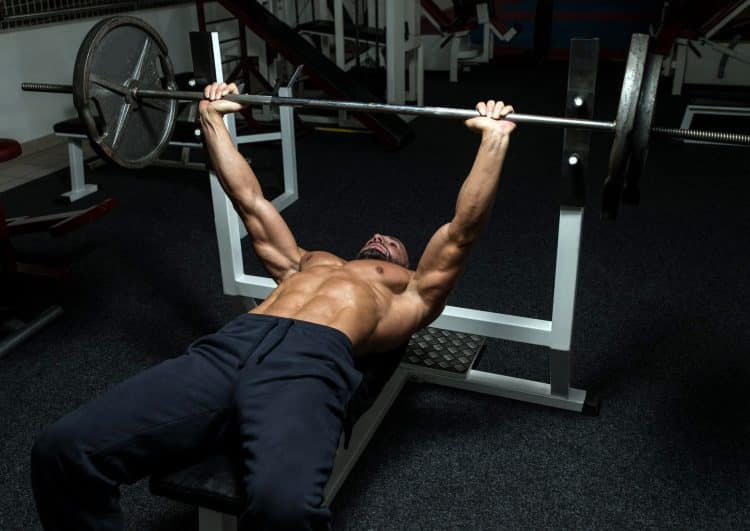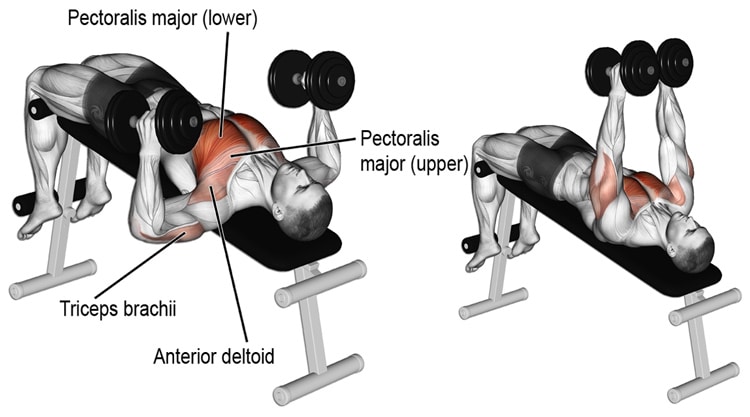The set is the basis of everything you do in the gym. It comprises a certain number of reps, after which you rest briefly before moving on to your next set. But, just as there’s more than one way to skin a cat, there are several ways to structure your sets. If your goal is to lift as heavy as possible and turn up the intensity, then you need to know about cluster sets.
Cluster sets are an advanced training technique, but there is some confusion surrounding them. Some people confuse them with rest-pause training, while others mix them up with drop sets. In this article, we’ll clear up the confusion as we explain exactly what cluster sets are, why they’re a good technique for increasing strength and muscle, and how you can program them into your routine.
What are Cluster Sets?

Cluster sets are like a series of mini-sets within a larger set. You do a certain number of reps, then rest for a few seconds before doing the next cluster of reps. Typically, a cluster set will consist of three or four of these mini-sets. Cluster sets are considered an inter-set form of training.
Cluster set training is popular among powerlifters and other strength athletes. There is a large body of research investigating its benefits to enhance strength and power. That research tells us that different forms of cluster training are more beneficial for different outcomes.
There are three primary reasons that you would include cluster set training in your routine:
- Strength
- Power
- Hypertrophy
When it comes to power training, the goal is to develop explosiveness. You should use a reduced weight that is 40 to 65% of your one-rep max. The focus will be on completing three to five clean, explosive reps. You then rest for around 20 seconds before completing the same number of reps again. You will usually complete three of these many sets while focusing on maintaining excellent form and producing as much explosive power as possible.
Power training cluster sets aim to train for power rather than exhausting your muscle fibers. This type of training has also been shown to improve the neurological pathways between your muscles and brain.
Cluster sets for strength training should see you working with between 80 and 90% of your one-rep max. So you might take a weight that you can perform four reps on and do two reps. You then rest for around 30 seconds and then do two more. If you did this for a total of four mini-sets of two reps each, you would end up doing eight reps within that cluster set. That represents double the volume and a substantially increased amount of intensity compared to if you were to just do a traditional set of four reps.
When it comes to hypertrophy, cluster sets are an excellent intensity-enhancing tool. That is because it allows you to train with heavier weights than you could usually do to complete the set. It also increases your time under tension. But unlike traditional sets, where it’s usually only the last two or three reps that could be described as high threshold time under tension, with cluster sets, every rep is a high threshold time under tension rep.
Finally, cluster sets allow you to achieve muscle overload. For example, you might choose a weight with which you could normally do eight reps and perform a cluster set of six, four, and three-rep mini sets. That’s a total of 13 reps — five more than you previously would have done.
Cluster Set Research
The vast majority of the research into cluster sets focuses on strength and power training. This research highlights five key benefits of cluster set training.

Rep Quality
According to some research, cluster set training improves the technical precision of each rep within the cluster set. That makes sense because, unlike with straight-set training, there is no fatigue accumulation to impair performance on the last few reps. Doing a technically demanding exercise like the clean and jerk or snatch using the standard high rep approach can lead to form breakdown. However, when you’re only doing a couple of reps and then having a short rest, you are far more likely to maintain correct form. [1]
Greater Power Output
Research suggests cluster sets can result in greater power output on each rep than straight-set training. Again that’s because there is less accumulated fatigue going into each new rep. Greater power output means more explosiveness in sports like basketball, football, and powerlifting. [2]
Reduced Inter-Set Fatigue
Cluster set training, when done in power training and strength training style, will reduce the cumulative fatigue effect from set to set and exercise to exercise. This is beneficial when you want to move to a new exercise fresh and relatively unaffected from the previous exercise. That is what you want when you are training for power and strength. With hypertrophy training, of course, your goal is the opposite — you want to increasingly fatigue the muscle as the workout progresses. [3]
Power Endurance
A 2008 study showed that cluster set training could help develop power endurance very effectively. This type of muscular endurance is needed by cyclists, soccer players, and people who play racquet sports. [4]
Increased Strength and Power
Cluster sets have been shown to produce superior results than traditional straight sets in terms of power and strength gains. In a 2013 study, 22 men were assigned to either a cluster set or a traditional set training protocol. Each group followed a 12-week training program. At the end of the study, the cluster set group showed significantly greater improvement in the bench press, vertical jump, and squat. However, the two groups had no significant difference in lean mass gains. [5]
What a Hypertrophy Cluster Set Looks Like

When using cluster set training as part of your muscle-building routine, you should select a weight that allows you to perform eight reps if you were lifting in traditional set form. On the first set, perform six reps, even though you know you could do a couple more.
Now rest for exactly 20 seconds. During that rest period, put the weight down and let go of the bar.
On the next mini-set, leave one rep in the tank. So, if you know that you can get five reps, stop after the fourth rep. Rest for another 20 seconds, then go to failure, which will probably be around three or four reps.
You can also experiment with higher starting reps. So you might begin with the weight you can do for 12 reps. In this case, you perform ten reps, rest for 20 seconds, then do your next mini-set, stopping with one rep in reserve. In the final mini-set, you go to failure.
What Exercises Should You Use for Cluster Set Training?
The exercises you choose for cluster set training will depend on your objective. If you’re using it for power or strength training, compound exercises like squats, deadlifts, and bench presses are ideal. With this type of training, you’re using 50 to 65% of your one-rep max. That means your risk of injury due to muscular failure and form breakdown is relatively low.
However, when using cluster sets for hypertrophy training, your muscular fatigue goes through the roof. That increases the likelihood that you will fail on the last rep or two of the cluster set. You want to avoid that from happening when using maximum weights on compound movements like the squat or bench press. For that reason, you should select exercises that are relatively safe if you fail on a rep.
So, rather than doing a cluster set on squats when training quads, do it on the leg press. If you fail on the last rep of a leg press, you won’t injure yourself the way you could on a squat. Similarly, when training the chest, you are better off using dumbbells or a chest press machine than a barbell. All those options will allow you to bail out of a rep without ending up with 90% of your one-rep max crushing down on your rib cage.
What an Explosive Power Cluster Set Looks Like
When using cluster sets for explosive power development, you should reduce the weight to about 50-65% of your one-rep max. Compared to hypertrophy or strength training, your reps will be relatively high.
For example, if you were doing squats, you might choose a weight with which you can do 10 quality reps. Perform five clean reps, concentrating on an explosive drive out of the hole on each rep. Now re-rack the weight and rest for exactly 30 seconds. Now do another five reps. Complete for a total of three mini sets within the cluster set.
Perform three or four cluster sets as part of your power training program one or two times per week.

What an Explosive Power Cluster Set for Strength Looks Like
Cluster sets for strength training typically involve the use of heavier weights than for hypertrophy or power. Choose a weight that is between 80-90% of your one-rep max and keep each mini-set to 1-2 reps. Here’s what that might look like for deadlifts:
- Load the bar with 85% of your one-rep max.
- Perform two reps.
- Rest for 30 seconds.
- Do your second mini-set of two reps.
- After another 30-second rest, complete your third and final mini-set of two reps.
Complete a total of three cluster sets to complete your deadlift workout. Your rest between cluster sets should be 3-5 minutes.
How To Program Cluster Sets into Your Routine
When training for muscle gain, you don’t want to do cluster sets at the beginning of your workout. That’s because they are so fatiguing that your performance on the rest of the workout will probably be compromised. You should add a cluster set on the third exercise for a body part. For example, if you are training your chest, you might begin with three or four sets of dumbbell bench presses, then go to the incline barbell bench press for four sets before moving to the Hammer Strength machine chest press. This is the exercise you should do a cluster set on. Make it the final set for that exercise.
So, if you are doing the Hammer Strength machine chest press, you might do two sets of 10 reps. The third and final set is going to be a cluster set. If you were doing a traditional set with the same weight you did on the previous set, you might be able to get eight reps. It is because you’re fatigued and can’t get to the 10 reps of the previous set. For the cluster set, though, you will pump out six reps. You then rest for exactly 20 seconds and do another four reps. After another 20-second recovery, you keep going to failure. That might be three or four reps, taking your total for the cluster set to 13 or 14 reps.
At this point of your workout, your chest muscle fibers will be on fire. However, you may choose to do a final exercise. This will likely be an isolation move like dumbbell flyes or the pec dec. If you can handle it, do a final cluster set on the last set of that exercise to max out the intensity of your chest workout.
So, as you can see from the example, just one or two cluster sets per workout are all you need. This is an extremely intense form of training that places exceptionally heavy demands on your muscle fibers. If you overuse the technique, you will overtax the muscle and inhibit your ability to recover fully between workouts.

Who Should Use Cluster Sets?
Cluster set training is not designed for beginners. If you are still within your first two years of consistently working out, you should stick with traditional sets. They will give you all the muscle stimulation you need for growth. Then, once you’ve been training for a couple of years, have built your strength base, and are able to develop the mind-muscle connection that you need to know how many reps you’ve got left in the tank, then you can start experimenting with cluster sets.
The more advanced you become, the more beneficial cluster sets will be for you. The longer you’ve been training, the harder it will be to keep making strength and muscle gains. So an advanced technique like this will help you to push the envelope.
FAQs
Are cluster sets the same thing as rest-pause training?
Though cluster sets and rest-pause training are very similar, the key difference is that cluster sets are pre-programmed. At the outset, you know how many reps to do in all but the last mini-set (which is to failure). You also know how long your rest between each mini-set will be. When it comes to rest-pause training, though, you do reps to failure, then rest for just long enough to allow you to pump out another 2 or 3 reps.
How do cluster sets differ from drop sets?
Drop sets and cluster sets are both an extended set form of training. With drop sets, though, you start with a weight that will allow you to perform 6-8 reps. You then immediately decrease the weight slightly and pump out another few reps. You continue doing this for further drops until you reach muscle failure.
In contrast, cluster sets involve using the same weight for each of the mini sets that make up the cluster set.
Are cluster sets effective for building muscle?
Yes, cluster sets are an effective muscle-building strategy. It allows you to increase your training volume and time under tension while pushing a muscle to maximum fiber stimulation. This advanced technique can help you break through a muscle-building plateau and continue making progress.
How are cluster sets written on an exercise program?
Cluster sets can appear a bit like an algebra equation when you first see them. Here’s what they look like:
1(4 x 4) -20s w/ a 6RM
This means you will do one cluster set consisting of four mini-sets of four reps. Your rest between each mini-set will be 20 seconds. You will choose a weight that you can do six reps with.
Wrap Up
Cluster sets are a safe, effective way to maximally stimulate your muscle fibers for muscle gain. They are also great for increasing strength and power with load and rep modifications. This is a tool to be used in a careful, targeted manner. If you aim to build muscle, you don’t have to do more than one or two cluster sets in your workout to achieve results. Program them towards the end of the workout, during the third or fourth exercise, for maximum benefit.
References
- Haff, Guy & Hobbs, Ryan & Haff, Erin & Sands, William & Pierce, Kyle & Stone, Michael. (2008). Cluster Training: A Novel Method for Introducing Training Program Variation. Strength & Conditioning Journal. 30. 67-76. 10.1519/SSC.0b013e31816383e1.
- Lawton TW, Cronin JB, Lindsell RP. Effect of interrepetition rest intervals on weight training repetition power output. J Strength Cond Res. 2006 Feb;20(1):172-6. doi: 10.1519/R-13893.1. PMID: 16503678.
- Lawton, Trent & Cronin, John & Lindsell, Rod. (2006). Effect of Interrepetition Rest Intervals on Weight Training Repetition Power Output. Journal of strength and conditioning research / National Strength & Conditioning Association. 20. 172-6. 10.1519/R-13893.1.
- Haff, Guy & Burgess, SJ & Stone, Michael. (2008). Cluster training: theoretical and practical applications for the strength and conditioning professional. Prof. Strength and Cond.. 12. 12-17.
- Oliver JM, Jagim AR, Sanchez AC, Mardock MA, Kelly KA, Meredith HJ, Smith GL, Greenwood M, Parker JL, Riechman SE, Fluckey JD, Crouse SF, Kreider RB. Greater gains in strength and power with intra set rest intervals in hypertrophic training. J Strength Cond Res. 2013 Nov;27(11):3116-31. doi: 10.1519/JSC.0b013e3182891672. PMID: 23736782.
